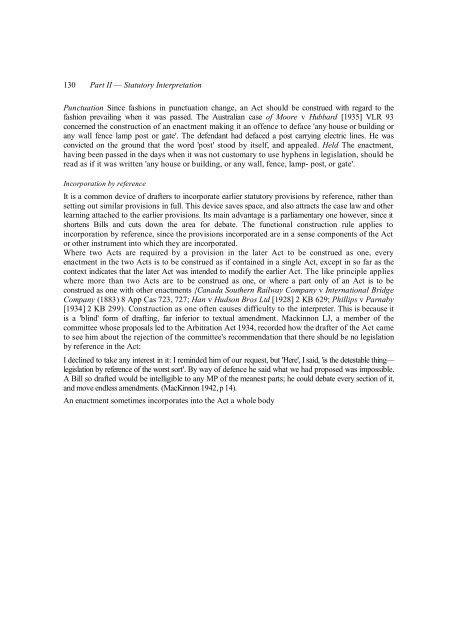Statutory Interpretation The Technique of Statutory ... - Francis Bennion
Statutory Interpretation The Technique of Statutory ... - Francis Bennion
Statutory Interpretation The Technique of Statutory ... - Francis Bennion
Create successful ePaper yourself
Turn your PDF publications into a flip-book with our unique Google optimized e-Paper software.
130 Part II — <strong>Statutory</strong> <strong>Interpretation</strong><br />
Punctuation Since fashions in punctuation change, an Act should be construed with regard to the<br />
fashion prevailing when it was passed. <strong>The</strong> Australian case <strong>of</strong> Moore v Hubbard [1935] VLR 93<br />
concerned the construction <strong>of</strong> an enactment making it an <strong>of</strong>fence to deface 'any house or building or<br />
any wall fence lamp post or gate'. <strong>The</strong> defendant had defaced a post carrying electric lines. He was<br />
convicted on the ground that the word 'post' stood by itself, and appealed. Held <strong>The</strong> enactment,<br />
having been passed in the days when it was not customary to use hyphens in legislation, should be<br />
read as if it was written 'any house or building, or any wall, fence, lamp- post, or gate'.<br />
Incorporation by reference<br />
It is a common device <strong>of</strong> drafters to incorporate earlier statutory provisions by reference, rather than<br />
setting out similar provisions in full. This device saves space, and also attracts the case law and other<br />
learning attached to the earlier provisions. Its main advantage is a parliamentary one however, since it<br />
shortens Bills and cuts down the area for debate. <strong>The</strong> functional construction rule applies to<br />
incorporation by reference, since the provisions incorporated are in a sense components <strong>of</strong> the Act<br />
or other instrument into which they are incorporated.<br />
Where two Acts are required by a provision in the later Act to be construed as one, every<br />
enactment in the two Acts is to be construed as if contained in a single Act, except in so far as the<br />
context indicates that the later Act was intended to modify the earlier Act. <strong>The</strong> like principle applies<br />
where more than two Acts are to be construed as one, or where a part only <strong>of</strong> an Act is to be<br />
construed as one with other enactments {Canada Southern Railway Company v International Bridge<br />
Company (1883) 8 App Cas 723, 727; Han v Hudson Bros Ltd [1928] 2 KB 629; Phillips v Parnaby<br />
[1934] 2 KB 299). Construction as one <strong>of</strong>ten causes difficulty to the interpreter. This is because it<br />
is a 'blind' form <strong>of</strong> drafting, far inferior to textual amendment. Mackinnon LJ, a member <strong>of</strong> the<br />
committee whose proposals led to the Arbitration Act 1934, recorded how the drafter <strong>of</strong> the Act came<br />
to see him about the rejection <strong>of</strong> the committee's recommendation that there should be no legislation<br />
by reference in the Act:<br />
I declined to take any interest in it: I reminded him <strong>of</strong> our request, but 'Here', I said, 'is the detestable thing—<br />
legislation by reference <strong>of</strong> the worst sort'. By way <strong>of</strong> defence he said what we had proposed was impossible.<br />
A Bill so drafted would be intelligible to any MP <strong>of</strong> the meanest parts; he could debate every section <strong>of</strong> it,<br />
and move endless amendments. (MacKinnon 1942, p 14).<br />
An enactment sometimes incorporates into the Act a whole body

















